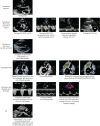Definition, classification and diagnosis of pulmonary hypertension
- PMID: 39209475
- PMCID: PMC11533989
- DOI: 10.1183/13993003.01324-2024
Definition, classification and diagnosis of pulmonary hypertension
Abstract
Pulmonary hypertension (PH) is a haemodynamic condition characterised by elevation of mean pulmonary arterial pressure (mPAP) >20 mmHg, assessed by right heart catheterisation. Pulmonary arterial wedge pressure (PAWP) and pulmonary vascular resistance (PVR) distinguish pre-capillary PH (PAWP ≤15 mmHg, PVR >2 Wood Units (WU)), isolated post-capillary PH (PAWP >15 mmHg, PVR ≤2 WU) and combined post- and pre-capillary PH (PAWP >15 mmHg, PVR >2 WU). Exercise PH is a haemodynamic condition describing a normal mPAP at rest with an abnormal increase of mPAP during exercise, defined as a mPAP/cardiac output slope >3 mmHg/L/min between rest and exercise. The core structure of the clinical classification of PH has been retained, including the five major groups. However, some changes are presented herewith, such as the re-introduction of "long-term responders to calcium channel blockers" as a subgroup of idiopathic pulmonary arterial hypertension, the addition of subgroups in group 2 PH and the differentiation of group 3 PH subgroups based on pulmonary diseases instead of functional abnormalities. Mitomycin-C and carfilzomib have been added to the list of drugs with "definite association" with PAH. For diagnosis of PH, we propose a stepwise approach with the main aim of discerning those patients who need to be referred to a PH centre and who should undergo invasive haemodynamic assessment. In case of high probability of severe pulmonary vascular disease, especially if there are signs of right heart failure, a fast-track referral to a PH centre is recommended at any point during the clinical workup.
Copyright ©The authors 2024.
Conflict of interest statement
Conflict of interest: G. Kovacs reports grants from Janssen, Boehringer Ingelheim and European Respiratory Society, consultancy fees from MSD, Boehringer Ingelheim, AOP Orphan, Chiesi, Ferrer, Bayer, Janssen, GSK, Liquidia and AstraZeneca, payment or honoraria for lectures, presentations, manuscript writing or educational events from MSD, Boehringer Ingelheim, AOP Orphan, Chiesi, Ferrer, Bayer, Janssen, GSK, Liquidia and AstraZeneca, support for attending meetings from MSD, Janssen, Boehringer Ingelheim and AOP Orphan, and participation on a data safety monitoring board or advisory board with MSD, Boehringer Ingelheim, Ferrer and Liquidia. S. Bartolome reports grants from United Therapeutics and Gossamer Bio, and consultancy fees from Merck and Janssen. C.P. Denton reports grants from Abbvie, Arxx, Servier, Horizon and GlaxoSmithKline, consultancy fees from Janssen, GlaxoSmithKline, Bayer, Sanofi, Boehringer Ingelheim, Roche, CSL Behring, Corbus, Acceleron, Horizon, Arxx, Lilly, Novartis and Certa, and payment or honoraria for lectures, presentations, manuscript writing or educational events from Janssen, GlaxoSmithKline and Boehringer Ingelheim. M.A. Gatzoulis has no potential conflicts of interest to disclose. S. Gu reports grants from American Thoracic Society Early Career Investigator Award in Pulmonary Vascular Disease and Team PHenomenal Hope Global Impact Research Award. D. Khanna reports grants from NIH R01, DoD, Boehringer Ingelheim and Merck, consultancy fees from Abbvie, Amgen, Argenx, Boehringer Ingelheim, BMS, Cabaletta, Certa, Merck and Zura Bio, and participation on a data safety monitoring board or advisory board with Abbvie. D. Badesch reports grants from Acceleron/Merck, Arena/United Therapeutics, Altavant, Ikaria and AI Therapeutics, consultancy fees from Acceleron/Merck, a leadership role with PHA SLC, and stock (or stock options) with Johnson and Johnson. D. Montani reports grants from Acceleron, Janssen and Merck MSD, consultancy fees from Acceleron, Merck MSD, Janssen and Ferrer, and payment or honoraria for lectures, presentations, manuscript writing or educational events from Bayer, Janssen, Boehringer, Chiesi, GSK, Ferrer and Merck MSD.
Figures


Comment in
-
The Seventh World Symposium on Pulmonary Hypertension: our journey to Barcelona.Eur Respir J. 2024 Oct 31;64(4):2401222. doi: 10.1183/13993003.01222-2024. Print 2024 Oct. Eur Respir J. 2024. PMID: 39209470 Free PMC article.
References
MeSH terms
Substances
LinkOut - more resources
Full Text Sources
Medical
Research Materials
